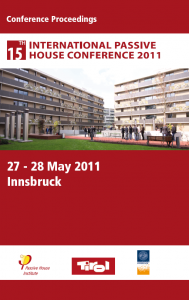Credit to: http://www.passiv.de/
scale: 642 pages
- 78 technical contribution in 16 working groups
- 29 Posterbeiträge
- 96 exhibitor
- for a nominal fee of 70,- Euro + post and package.
- Index
online ordering - http://www.passiv.de/07_eng/index_e.html
15th Passive House Conference – foreword from the editor
 The best energy is “less energy.” Good, energy-efficient solutions not only conserve energy but also improve comfort and safety. Energy efficiency is the most important, most affordable, and safest energy option and, at the same time, a basic requirement for a mostly renewable energy supply. It is therefore indispensable on the path to “nearly zero” energy – the path that the EU is taking in its current resolutions.
The best energy is “less energy.” Good, energy-efficient solutions not only conserve energy but also improve comfort and safety. Energy efficiency is the most important, most affordable, and safest energy option and, at the same time, a basic requirement for a mostly renewable energy supply. It is therefore indispensable on the path to “nearly zero” energy – the path that the EU is taking in its current resolutions.Conservation solutions interact to a great degree with regional value chains. Passive House is therefore attractive for all regions, since construction provides many jobs – and could provide even more, if the motto “if you’re gonna do it, do it right” is systematically applied to renovations. There is no question that forward-looking regions are doing all they can to support capacity-building for the Passive House Standard. The recently introduced qualification processes make it even easier to meet that need. Every region should be offered an opportunity, which in why the International Passive House Conference takes place at a different location every year. Visitors from around the world should be able to see the proceedings being made in a variety of regions.
The problems are global, but the solutions need to be implemented at the regional level, as this conference, once again, clearly shows. On behalf of the organizer, I would like to thank the many contributors, the scientific advisory board, the chairmen, the presenters and poster authors, the exhibitors, and the numerous helpers.
Prof. Dr. Wolfgang Feist; University of Innsbruck and scientific director at the Passive House Institute, organizer of the International Passive House Conferences.
| Innsbruck 2011 |

